How to Install Deluge BitTorrent Client on Ubuntu 18.04 Desktop and Server
This tutorial will be showing you how to install Deluge on Ubuntu 18.04 desktop and server. Deluge is a free, open-source (GPL3) and lightweight BitTorrent client, available for Linux, FreeBSD, Mac OS X and Windows. It has a rich collection of plugins that you can install to extend its functionality. For example, you can install the streaming plugin so you can stream video or audio directly from Deluge while downloading. The latest stable version, 1.3.15, was released on May 12, 2017.
Install Latest Version of Deluge on Ubuntu 18.04 Desktop from PPA
Ubuntu 18.04 software repository includes Deluge 1.3.15. However, when a newer version comes out, it would take some time for the Ubuntu team to update it. To ensure you get the newest version as soon as possible, you need to install it from official Deluge PPA. Open up a terminal window, then run the following 2 commands one at a time.
sudo add-apt-repository ppa:deluge-team/ppa sudo apt install deluge
Note that on Ubuntu 18.04, you don’t need to manually run sudo apt update after adding a PPA. It will run automatically. This PPA also works on other Linux distributions that are based on Ubuntu such as Linux Mint and Elementary OS. If you already have deluge installed, then the above commands will update your deluge to the latest version. Don’t worry, your existing torrents will be fine.
Once installed, you can start it from application menu.

Deluge 1.3.15 user interface
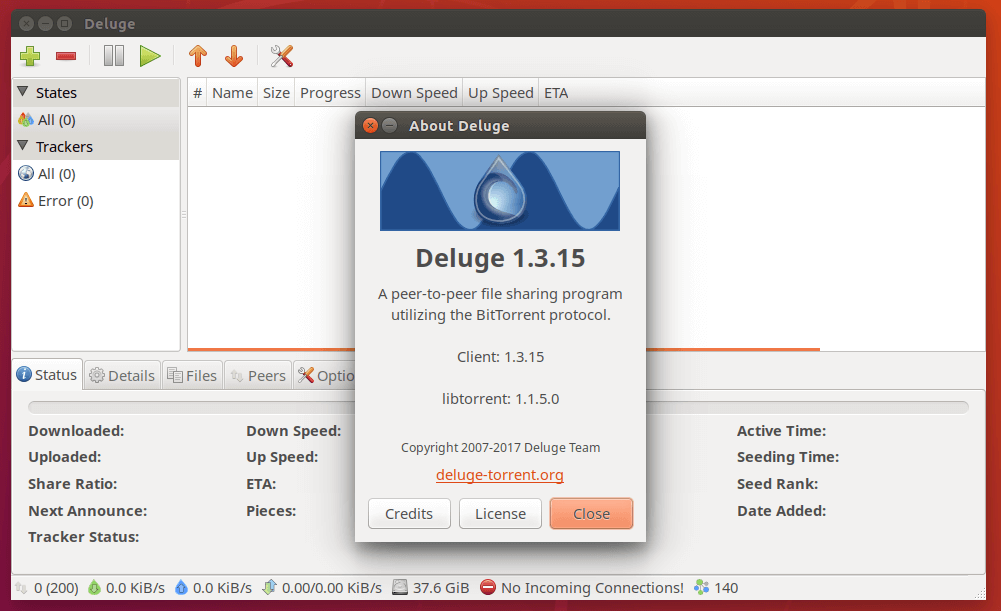
How to Enable Deluge Autostart on Ubuntu 18.04 Desktop
To enable autostart, open the Startup Applications from your applications menu. Then click Add button to add a new startup program. In the Name field, you can enter something like “Deluge GTK”. In the Command field, enter /usr/bin/python /usr/bin/deluge-gtk. You can leave the comment field blank. Click Add.
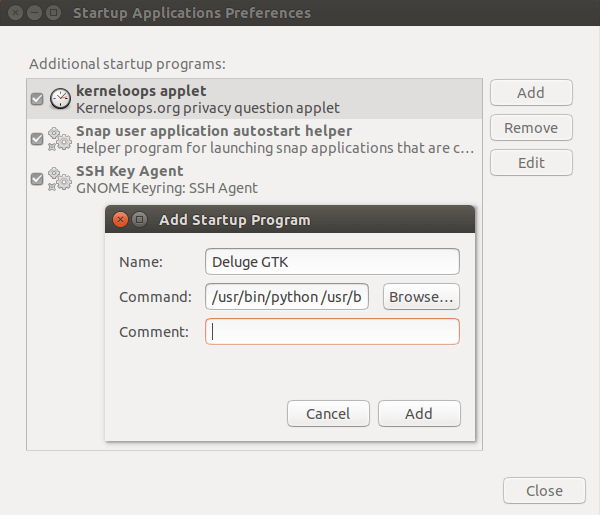
You may want to use a VPN to hide your IP address when downloading torrents.
Install Deluge BitTorrent on Ubuntu 18.04 Server
You can install Deluge BitTorrent daemon on a server and manage the program via the Deluge web interface (You control it in a web browser). Use the following command to install Deluge daemon and Deluge Web interface on Ubuntu 18.04 server.
sudo add-apt-repository ppa:deluge-team/ppa sudo apt install deluged deluge-webui
Then create the deluge user and group so that deluge can run as an unprivileged user, which will increase your server’s security.
sudo adduser --system --group deluge
The --system flag means we are creating a system user instead of normal user. A system user doesn’t have password and can’t login, which is what you would want for Deluge. A home directory /home/deluge/ will be created for this user. You may want to add your user account to the deluge group with the following command so that the user account has access to the files downloaded by Deluge BitTorrent. Files are downloaded to /home/deluge/Downloads by default. Note that you need to re-login for the groups change to take effect.
sudo gpasswd -a your-username deluge
Once that’s done, create a systemd service file for deluge with your favourite text editor such as nano.
sudo nano /etc/systemd/system/deluged.service
Copy and paste the following lines into the file.
[Unit] Description=Deluge Bittorrent Client Daemon After=network-online.target [Service] Type=simple User=deluge Group=deluge UMask=007 ExecStart=/usr/bin/deluged -d Restart=on-failure # Configures the time to wait before service is stopped forcefully. TimeoutStopSec=300 [Install] WantedBy=multi-user.target
To save a file in Nano text editor, press Ctrl+O, then press Enter to confirm. Now start deluge deamon with the following command. Since we want Deluge to run as the deluge user, there’s no need to add sudo to the command, but you will be asked to enter your password.
systemctl start deluged

You may also want to enable auto start when Ubuntu 18.04 is booting up.
systemctl enable deluged
Check Deluge status:
systemctl status deluged
You can see that deluged is running and autostart is enabled. If it’s exited or isn’t running, you may need to restart it with systemctl restart deluged.

Accessing Deluge WebUI
To be able to access the deluge WebUI, we also need to create a systemd service file for deluge web.
sudo nano /etc/systemd/system/deluge-web.service
Copy and paste the following texts into the file.
[Unit] Description=Deluge Bittorrent Client Web Interface After=network-online.target [Service] Type=simple User=deluge Group=deluge UMask=027 ExecStart=/usr/bin/deluge-web Restart=on-failure [Install] WantedBy=multi-user.target
Save and close the file. Then start and enable deluge-web, check its status. Again, there’ no need to add sudo to the commands.
systemctl start deluge-web systemctl enable deluge-web systemctl status deluge-web
Once the deluge-web service is running, it listens on TCP port 8112. Now in your Web browser address bar, type
your-server-ip:8112
You will be asked to enter a password, which by default is deluge, to access the Web UI. (Your firewall might be preventing access to port 8112, so check your firewall setting if you can’t access the web UI).
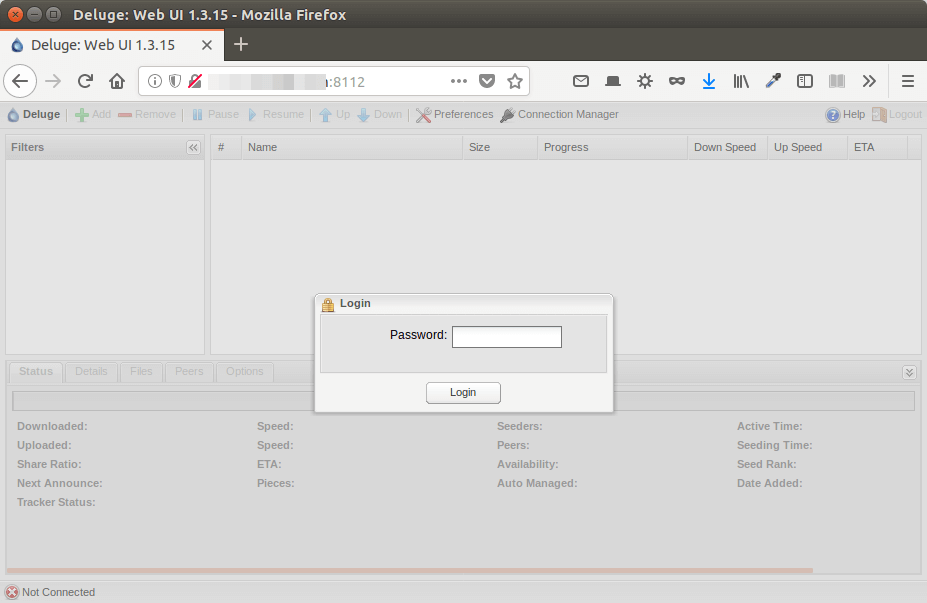
It’s recommended to change the default password. After you choose to change password, the connection manager window will pop up asking you to connect to Deluge daemon which is listening on 127.0.0.1:58846. Select the connection and click Connect button.
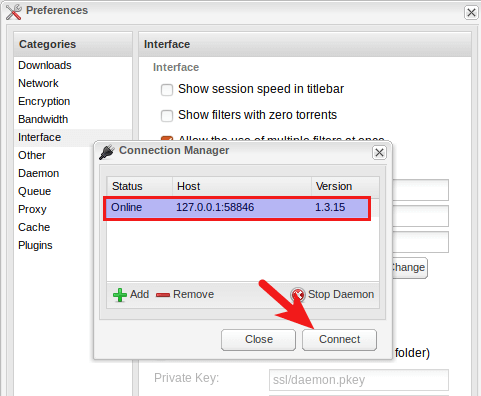
Then you will be able to change the WebUI password. Note that you need to click the Change button to apply this change.

And now you can use Deluge BitTorrent on your Ubuntu 18.04 server from the web interface.
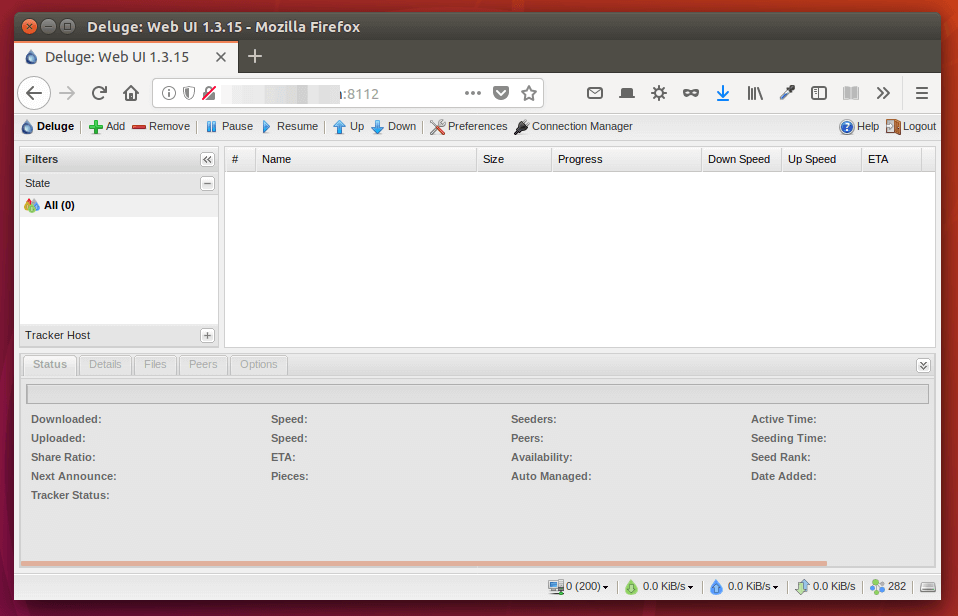
To add new torrents, click the add button on the upper left corner. You can add a torrent file from your local computer or add magnet link. By default, files are downloaded to /home/deluge/Downloads directory.
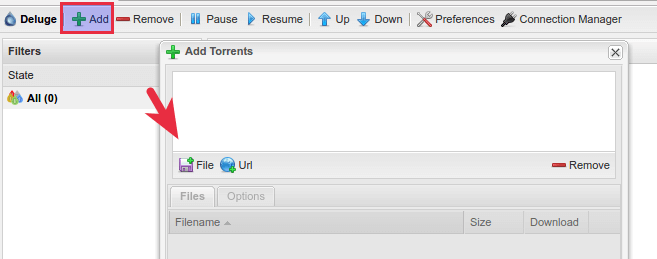
Set Up Nginx Reverse Proxy for Deluge WebUI
A reverse proxy is a proxy for another server, in this case the Deluge WebUI. First install Nginx on Ubuntu 18.04.
sudo apt install nginx
Start Nginx
sudo systemctl start nginx
Then create a Nginx server block file for Deluge WebUI.
sudo nano /etc/nginx/conf.d/deluge-webui.conf
Copy and paste the following texts into the file. Replace the red-colored text with your own domain name. You should also set the A record for your domain name.
server {
listen 80;
server_name torrent.yourdomain.com;
access_log /var/log/nginx/torrent.yourdomain.com.access;
error_log /var/log/nginx/torrent.yourdomain.com.error;
location / {
proxy_pass http://127.0.0.1:8112;
}
}
Save and close the file. Then test Nginx configuration.
sudo nginx -t
If the test is successful, reload Nginx
sudo systemctl reload nginx
Now you can access Deluge WebUI via your domain name (torrent.yourdomain.com). Now you may want the deluge-web process to listen only on localhost (127.0.0.1), so that it’s not exposed to the Internet. To achieve that, we need to edit the systemd service file.
sudo nano /etc/systemd/system/deluge-web.service
Find the following line.
ExecStart=/usr/bin/deluge-web
Change it to
ExecStart=/usr/bin/deluge-web -i 127.0.0.1
Save and close the file. Then reload systemd daemon.
systemctl daemon-reload
And restart deluge-web service.
systemctl restart deluge-web
You can check the listening status with:
sudo netstat -lnpt | grep 8112
Enable HTTPS
To secure the Web UI, you can install a free Let’s Encrypt certificate. First you need to install the Let’s Encrypt client (certbot) on Ubuntu 18.04 server.
sudo apt install software-properties-common sudo add-apt-repository ppa:certbot/certbot sudo apt install certbot python3-certbot-nginx
Python3-certbot-nginx is the Certbot Nginx plugin. After they are installed, run the following command to automatically obtain and install Let’s Encrypt certificate.
sudo certbot --nginx --redirect --agree-tos --hsts --staple-ocsp --email your-email-address -d torrent.yourdomain.com
Once that’s done, refresh deluge Web UI. It will be automatically redirected to HTTPS connection.
I hope this tutorial helped you install Deluge on Ubuntu 18.04 desktop or server. As always, if you found this post useful, then subscribe to our free newsletter to get more tips and tricks. Take care.



I don’t know if you want to update this guide?
But when starting the service I came across this error:
The warning already told you what you need to do: run
systemctl daemon-reload, then restart delugedsystemctl restart delugedIf you’re running ubuntu server (at least for 18.04.1), you’ll find missing dependencies when apt installing deluged. add-apt-repository universe solves this.
Thankyou, so much.
Thanks. That helped a lot.
Everything worked great until virtual host part.
I already have ssl enabled, port 80 is blocked and everything goes through 443
I tried changing “listen 443” but no joy
any help?
You can use PageKite to bypass ISP restrictions. Here’s a detailed tutorial: https://www.linuxbabe.com/linux-server/expose-local-web-server-pagekite
I know where I went wrong now, I didn’t create an A record for torrent.domain
all working now, thank you!!
what do you think of conf.d vs sites-available/enabled
sites-available/enabled is a debian/Ubuntu specific thing. The upstream Nginx package does not use these two directories.
There’s no real difference between conf.d and sites-available/enabled. Both of them need to be included in nginx.conf before you can use them. I choose to use conf.d because I don’t have to run another command to create symbolic link.
I have the issue where I try to visit the website and I get greeted by “Welcome to nginx!”
It was working before I enable the https part.
Also I’m not sure if I add the “A record” correctly. I went in to
/etc/hosts
and added:
192.168.1.xx torrent.mydomain.com
where I ofc replaced xx and torrent.mydomain.com
is this the correct way of doing it?
Also I tried changing the listen port to 443 since it’s https but then I don’t get any website, just connection refused.
Hi, to access deluge from outside network via a domain name, first you need to buy a domain name. I recommend NameCheap because the price is low and you get whois privacy protection free for life.
To create A record, go to the domain registrar’s DNS manager and point your domain name to your public IP address.
I’m using no-ip and it’s linked to my IP.
The problem is when I connect to the mydns.com with https enabled I get to the Nginx welcome page, telling me that I need to configure it.
If I disable the https and use http I get to deluge.
You can delete the default virtual host.
Then reload Nginx.
Did not help, then I get 404.
The problem is that it do not how to transfer the https to my 127.0.0.1:xxx
It works fine with http.
You don’t need to edit /etc/hosts file.
Please check Nginx error log (/var/log/nginx/error.log)
Removed the entry I had in hosts.
I tried to reinstall my cert with the command
sudo certbot –nginx –redirect –agree-tos –hsts –staple-ocsp –email your-email-address -d torrent.yourdomain.com
Now, trying to connect with https I get the error “ERR_TOO_MANY_REDIRECTS”.
The last entry in the error log is:
2018/11/13 11:00:41 [warn] 22186#22186: conflicting server name “domain.com” on 0.0.0.0:80, ignored
Change the listen port back to original in deluge. Then restart nginx.
Look for errors in the log, not warnings.
Reinstalled nginx, certbot python3-certbot-nginx and software-properties-common. now it’s working.
Thanks for this amazing how-to-tutorial !
However I didnt get it up and running following this guide 🙁
So if anyone get the same problems with the deluge-web(UI) not starting here is how to fix it:
Edit: ExecStart=/usr/bin/deluge-web
After Edit: ExecStart=/usr/bin/deluge-web -d
Save file: Ctrl+X+Y and hit Enter
Last but not least:
Hopefully it helps someone 🙂
Kinds Regards / Amadeus
That was my issue – thank you!
Thank you! This worked for me as well
Thank you for this guide it works perfect 🙂
One thing to mention, I feel that there is a step missing with ssl right at the end?
Thanks again!
Great tutorial! I was wondering though, how do I set up auto-connect with the daemon? There is no web.conf it seems…
Thanks in advance!
I’m not sure what you mean by “auto-connect with the daemon”.
Hey all,
This worked for me with some additional steps.
The trouble I had was connecting to the Web-UI from another PC. Here is what I did to resolve it.
1. Stop all instances of deluged and deluge-web.
2. Run deluged as local user (not the deluge user which we cannot log into). This will create /home/user/.config/deluge/core.conf
3. Kill the process deluged.
4. Create directories /home/deluge/.config/deluge/ as deluge
5. Modify /home/user/.config/deluge/core.conf to show “allow_remote”: true,
6. Copy /home/user/.config/deluge/core.conf to /home/deluge/.config/deluge/
7. Change ownership of /home/deluge/.config/deluge/core.conf to deluge:deluge
8. Delete /home/user/.config/deluge/
9. Startup deluged and deluge-web as per instructions.
Hope this helps someone else.
`A home directory /home/deluge/ will be created for this user` this is not correct. The “home” directory of a system user is `/var/lib/deluge` (at least on ubuntu – likely also debian and derivatives).
This is probably because you are installing a newer version of Deluge. I will check and update the article later.
Actually, I take that back. Later I found that it *is* created.
However, that is not what I want – or what should happen. On debian (and ubuntu) the normal user that deluged runs under is ‘debian-deluged’ which gets as home directory `/var/lib/deluged`. Although we DO want to change that user, because deluge seems to have a bug that makes it impossible to log into deluged using web-deluge when there is a ‘-‘ in the username (see https://forum.deluge-torrent.org/viewtopic.php?t=55340#p229626), it seems to make sense to still keep using `/var/log/deluged`. Unfortunately this requires to forcefully change the user and group of the following directories after installation of deluged: `sudo chown -R deluge:deluge /var/lib/deluged /var/log/deluged` which is slightly ugly since their user id and group is stored as part of the package installation (aka, what will happen when those packages are upgraded? I don’ t know yet.)
I am currently still fighting with getting this to work :/.
Ok, I got it to work. Since it is in some points significantly different from this HowTo, I hope you’ll allow me to add my solution here:
Installing deluge
Create a user group deluge/deluge
Add yourself to this group
Create the file /etc/systemd/system/deluged.service with the following contents:
Create directory:
Create the file /etc/systemd/system/deluged.service.d/user.conf with the following contents:
Create a log directory for Deluge and give the service user (e.g. deluge), full access:
Start the service:
Create the file /etc/systemd/system/deluge-web.service containing the following:
Create directory:
Create the file /etc/systemd/system/deluged.service.d/user.conf with the following contents:
Start the service:
Log files will be written to /var/log/deluge/.
Downloaded files need to written to a directory with write access for deluge:deluge
and gives also access to you (in group deluge). I use the following, where I download
to `/opt/verylarge/deluge/downloads` and move completed to `/opt/verylarge/deluge/completed`
Test:
Connect to http://localhost:8112/ with browser.
Password is ‘deluge’ – change it.
Hi. Following the guide, I had no issues installing Desktop and Server version. However, I don’t see my desktop torrents reflected in the server webui. Please advise, was there a step I missed? I downloads find in the desktop console.
The desktop version and server version are two separate programs. They don’t share torrents with each other.
Hi
Is there a way of completely removing deluge server version and all it’s components from my ubuntu server?
Thanks
Remove the binary.
Disable auto-start at boot time.
Remove the systemd service file
Remove Nginx configuration file.
Reload Nginx.
Hello.
On a debian system, but same setup as with deluged.service.
When i try to start the service as normal user i get error code “ExecStart …. (code=exited , status=216/GROUP)”
Any toughts?